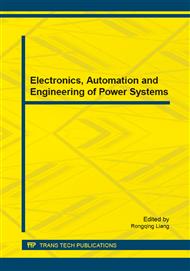[1]
L. Gyugyi and B.P. Pelly. Static Power Frequency Changers: Theory, Performance and Application. Willey-interscience, NewYork, (1976).
Google Scholar
[2]
M.Venturini, A New High SwitchingRate Direct Frequency converter, Italian Patent,1979 1207:70~79.
Google Scholar
[3]
Takei M; HaradaY; Ueno K 600V-IGBT with reverse blocking capability (2001).
Google Scholar
[4]
ATEN M; TOWERS G; WHITLEY C reliability comparison of matrix and other converter topologies 2006(03).
Google Scholar
[5]
KLUMPNER C; BLAABJERG F Modulation method for a multiple drive system based on a two-stage directpower conversion topology with reduced input current ripple 2003(04).
DOI: 10.1109/pesc.2003.1217671
Google Scholar
[6]
L. Huber, D. Borojevic, Space Vector Modulated Three-Phase to Three-phase atrix Converter with Input Power Factor Correction, IEEE Trans. IA, vol. 31, No. 6, pp.1234-1245, (1995).
DOI: 10.1109/28.475693
Google Scholar
[7]
NGUYEN M K. JUNG Y G. LIM Y C A single-phase z-source buck-boost matrix converter 2010(02).
Google Scholar
[8]
ALBERTO A; VENTURINI M Analysis and design of optimumamplitude nine-switch direct AC-AC converters[J] 1989(01).
Google Scholar
[9]
Wheeler P.W., Clare J.C. and Empringham L., A Vector Controlled MCT Matrix Converter Induction Motor Drive with Minimized Commutation Times and Enhanced Waveform Quality, IEEE IAS Meeting, October (2002).
DOI: 10.1109/ias.2002.1044127
Google Scholar
[10]
SANGSHIN K; HAMID A T An approach to fault-tolerant threephase matrix converter drives[J]2007(04).
Google Scholar
[11]
AlesinaA; Venturini G B Analysis and design of optimum amp litudenine-switch direct AC-ACconverters 1989(01).
Google Scholar
[12]
FREDE B; DOMENICO C; CHRISTIAN K Comparison of two current modulation strategies for matrix converters under unbalanced input voltage conditions[J] 2002(02).
Google Scholar
[13]
PABLO C; JOSE R; MARCO R Predictive control of an indirect matrix converter[J] 2009(06).
Google Scholar
[14]
Experimental evaluation of ride-through capabilitiesfor a matrix converter under short power interruptionsKlumpner, C. ; Blaabjerg, F. Industrial Electronics, IEEE Transactions on.
DOI: 10.1109/41.993264
Google Scholar
[15]
Power supply loss ride-through and device voltage drop compensation in a matrix converter permanent magnet motor drive for an aircraft actuatorWheeler, P.W. ; Clare, J.C. ; Apap, M. ; Empringham, L; Whitley, C ; Towers, G. Power Electronics Specialists Conference, 2004. PESC 04. 2004 IEEE 35th Annual.
DOI: 10.1109/pesc.2004.1355732
Google Scholar
[16]
A new ride-through approach for matrix converter fed adjustable speed drivesHan Ju Cha ; Enjeti, P.N. Industry Applications Conference, 2002. 37th IAS Annual Meeting. Conference Record of the.
DOI: 10.1109/ias.2002.1042806
Google Scholar
[17]
Extended ride-through capability for matrixconverter drives with continuous motor synchronizationWiechmann, E. P; Burgos, R. P; Rodriguez, J.R. Power Electronics, Machines and Drives, 2002. International Conference on (Conf. Publ. No. 487).
DOI: 10.1049/cp:20020112
Google Scholar


